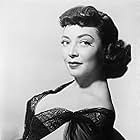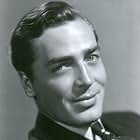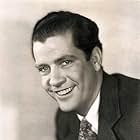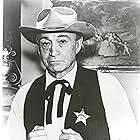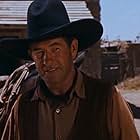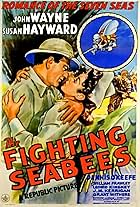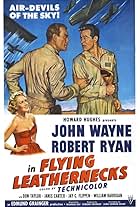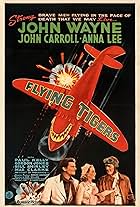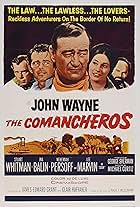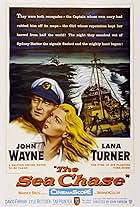IMDb RATING
6.4/10
3.7K
YOUR RATING
In 1818 Alabama, French settlers are pitted against greedy land-grabber Blake Randolph but Kentucky militiaman John Breen, who's smitten with French gal Fleurette De Marchand, comes to the s... Read allIn 1818 Alabama, French settlers are pitted against greedy land-grabber Blake Randolph but Kentucky militiaman John Breen, who's smitten with French gal Fleurette De Marchand, comes to the settlers' aid.In 1818 Alabama, French settlers are pitted against greedy land-grabber Blake Randolph but Kentucky militiaman John Breen, who's smitten with French gal Fleurette De Marchand, comes to the settlers' aid.
Fred Aldrich
- Militiaman
- (uncredited)
- Director
- Writer
- All cast & crew
- Production, box office & more at IMDbPro
Storyline
Did you know
- TriviaJohn Wayne was so pleased with the chemistry between him and Oliver Hardy that he offered Hardy the role of "permanent comic sidekick" in subsequent movies. By the time this picture was released, Stan Laurel had recovered from his illness and was able to return to the Laurel & Hardy team so Hardy declined Wayne's offer.
- GoofsAuto tire tracks visible in dust during wagon and horse chase scene.
- Quotes
[repeated line]
Willie Paine: I'll see to the horses.
- Alternate versionsAlso available in a computer colorized version.
- ConnectionsFeatured in Frances Farmer Presents: The Fighting Kentuckian (1959)
- SoundtracksLet Me Down, Oh Hangman
(uncredited)
Traditional
Music Arranged by George Antheil
New Lyrics by George Waggner
Featured review
By 1949 Laurel and Hardy were all but finished (we don't talk about 'Atoll K') but Oliver Hardy, always hard up, needed to work. Hence this unique but worthwhile turn as a genial Southron in George Waggner's middling-good oater.
John Wayne-- Republic's chief asset and now his own producer-- and Vera Hruba Ralston, its boss's wife-- were co-starring in a slightly unusual western. It is set in 1819, heyday of Andrew Jackson's 'manifest destiny' expansionism. French settlers in the Deepest South, Napoleonic exiles, were slogging it out with English-speakers for the ownership of a bit of Creole country.
Wayne and Hardy, attired like Davy Crocketts, are teamed as old Kentuckian pals, veterans of the Battle of New Orleans. Now they're on the loose in Alabama and (since this was still the gallant, humorous Wayne of post-'Stagecoach' vintage) assisting French settlers against larcenous land barons such as John Howard.
Contrary to what lazy film writers maintain, 'Repulsive Pictures', as some jaded employees called it, was never a pure Poverty Row outfit. By the late 1940s it was careful to keep Wayne's market value up by attention to production values, a policy which culminated in 'The Quiet Man'. Here gleaming photography by Lee Garmes and George Antheil's score enhance the Frenchified interest of the mise en scene, and there's a surfeit of plot. (Incidentally Vera Ralston is no worse than many a Maureen O'Sullivan either, despite the cries of uxoriousness against Herbert Yates, Mr Ralston.)
Once again the factor that lifted Wayne above the Audie Murphys and Randolph Scotts is visible abundantly: the charm and grace he cannot help exhibiting, even though he'd have knocked a man down for mentioning them. The lightness and assurance he projects makes it not crazy to compare him with Cary Grant-- who was also at his most beguiling when portraying embarrassment, despite his reputation for smoothness. It has kept many of Wayne's seemingly routine pictures fresh when more pompous major productions have long since become fossilised.
Hardy's main job is to inject slapstick or advise and admonish his chum when Wayne gets too romantic, but he is involved in the mechanics of the plot too. He does so well one feels that if 'Babe' had been less fond of the golf course and in better health, he could have followed many funny men before him into a second life as a character actor.
Used to equality in a double act, Hardy works well with Big John: there's a genuine warmth between them, since unlike too many comics Ollie does not try to dominate their interchanges. Nor does he use the broader schticks of his peerless partnership: he does not mutely appeal to the audience or speak in that slow, absurdly dignified way he uses to challenge Stan's stupidities. He is given business with hats, eats too much, twiddles his incongruously delicate fingers, falls in a river as in 'Way Out West'. But it's all done lightly; Willie Paine's a bit of a clown but not a gross buffoon.
Seeing Babe slugging and being slugged is novelty enough, and there is poignancy in his last shot: marching away at the wedding, as if bidding farewell unknowingly to his Hollywood career. It's an unexpected coda, a box office success to boot, and a heartwarming one after years stuck in unworthy programmers with Stan for Darryl F Zanuck.
John Wayne-- Republic's chief asset and now his own producer-- and Vera Hruba Ralston, its boss's wife-- were co-starring in a slightly unusual western. It is set in 1819, heyday of Andrew Jackson's 'manifest destiny' expansionism. French settlers in the Deepest South, Napoleonic exiles, were slogging it out with English-speakers for the ownership of a bit of Creole country.
Wayne and Hardy, attired like Davy Crocketts, are teamed as old Kentuckian pals, veterans of the Battle of New Orleans. Now they're on the loose in Alabama and (since this was still the gallant, humorous Wayne of post-'Stagecoach' vintage) assisting French settlers against larcenous land barons such as John Howard.
Contrary to what lazy film writers maintain, 'Repulsive Pictures', as some jaded employees called it, was never a pure Poverty Row outfit. By the late 1940s it was careful to keep Wayne's market value up by attention to production values, a policy which culminated in 'The Quiet Man'. Here gleaming photography by Lee Garmes and George Antheil's score enhance the Frenchified interest of the mise en scene, and there's a surfeit of plot. (Incidentally Vera Ralston is no worse than many a Maureen O'Sullivan either, despite the cries of uxoriousness against Herbert Yates, Mr Ralston.)
Once again the factor that lifted Wayne above the Audie Murphys and Randolph Scotts is visible abundantly: the charm and grace he cannot help exhibiting, even though he'd have knocked a man down for mentioning them. The lightness and assurance he projects makes it not crazy to compare him with Cary Grant-- who was also at his most beguiling when portraying embarrassment, despite his reputation for smoothness. It has kept many of Wayne's seemingly routine pictures fresh when more pompous major productions have long since become fossilised.
Hardy's main job is to inject slapstick or advise and admonish his chum when Wayne gets too romantic, but he is involved in the mechanics of the plot too. He does so well one feels that if 'Babe' had been less fond of the golf course and in better health, he could have followed many funny men before him into a second life as a character actor.
Used to equality in a double act, Hardy works well with Big John: there's a genuine warmth between them, since unlike too many comics Ollie does not try to dominate their interchanges. Nor does he use the broader schticks of his peerless partnership: he does not mutely appeal to the audience or speak in that slow, absurdly dignified way he uses to challenge Stan's stupidities. He is given business with hats, eats too much, twiddles his incongruously delicate fingers, falls in a river as in 'Way Out West'. But it's all done lightly; Willie Paine's a bit of a clown but not a gross buffoon.
Seeing Babe slugging and being slugged is novelty enough, and there is poignancy in his last shot: marching away at the wedding, as if bidding farewell unknowingly to his Hollywood career. It's an unexpected coda, a box office success to boot, and a heartwarming one after years stuck in unworthy programmers with Stan for Darryl F Zanuck.
- How long is The Fighting Kentuckian?Powered by Alexa
Details
Box office
- Gross US & Canada
- $1,550,000
- Runtime1 hour 40 minutes
- Color
- Aspect ratio
- 1.37 : 1
Contribute to this page
Suggest an edit or add missing content

Top Gap
By what name was The Fighting Kentuckian (1949) officially released in India in English?
Answer













